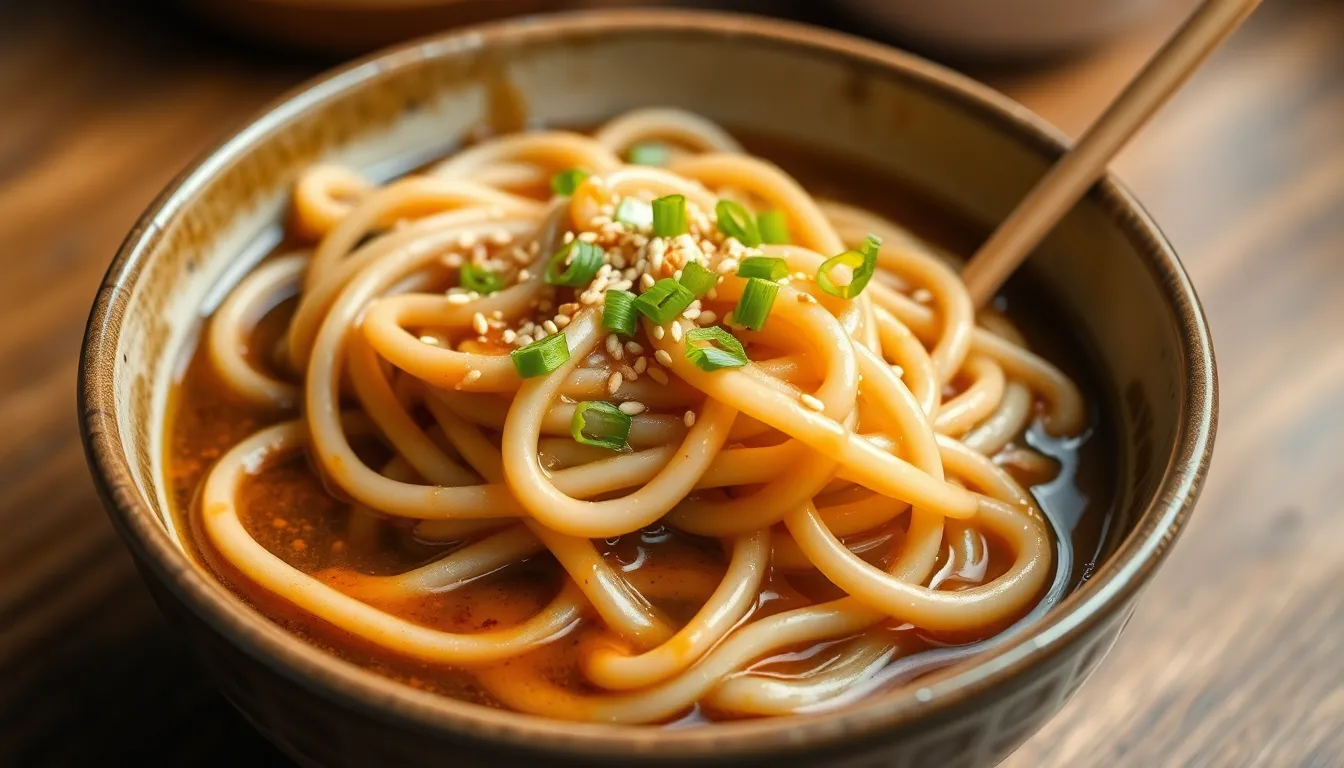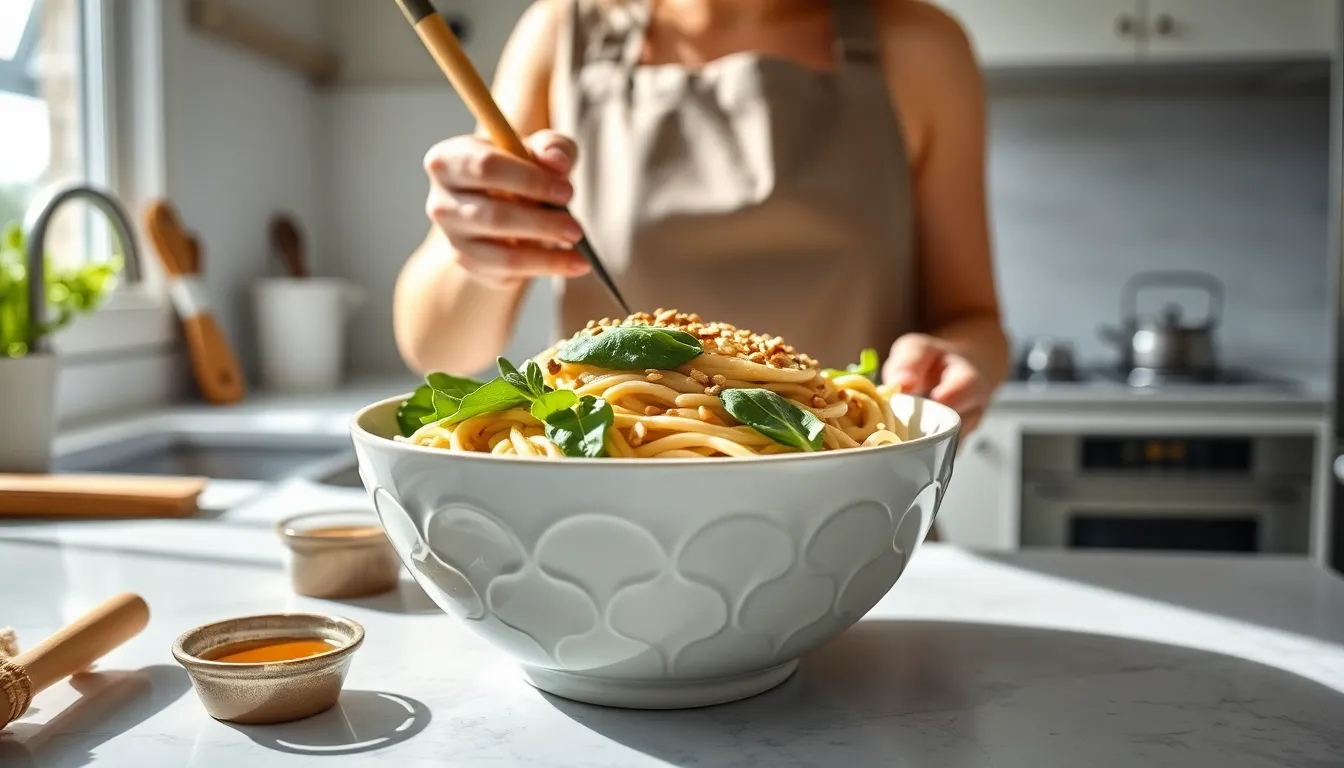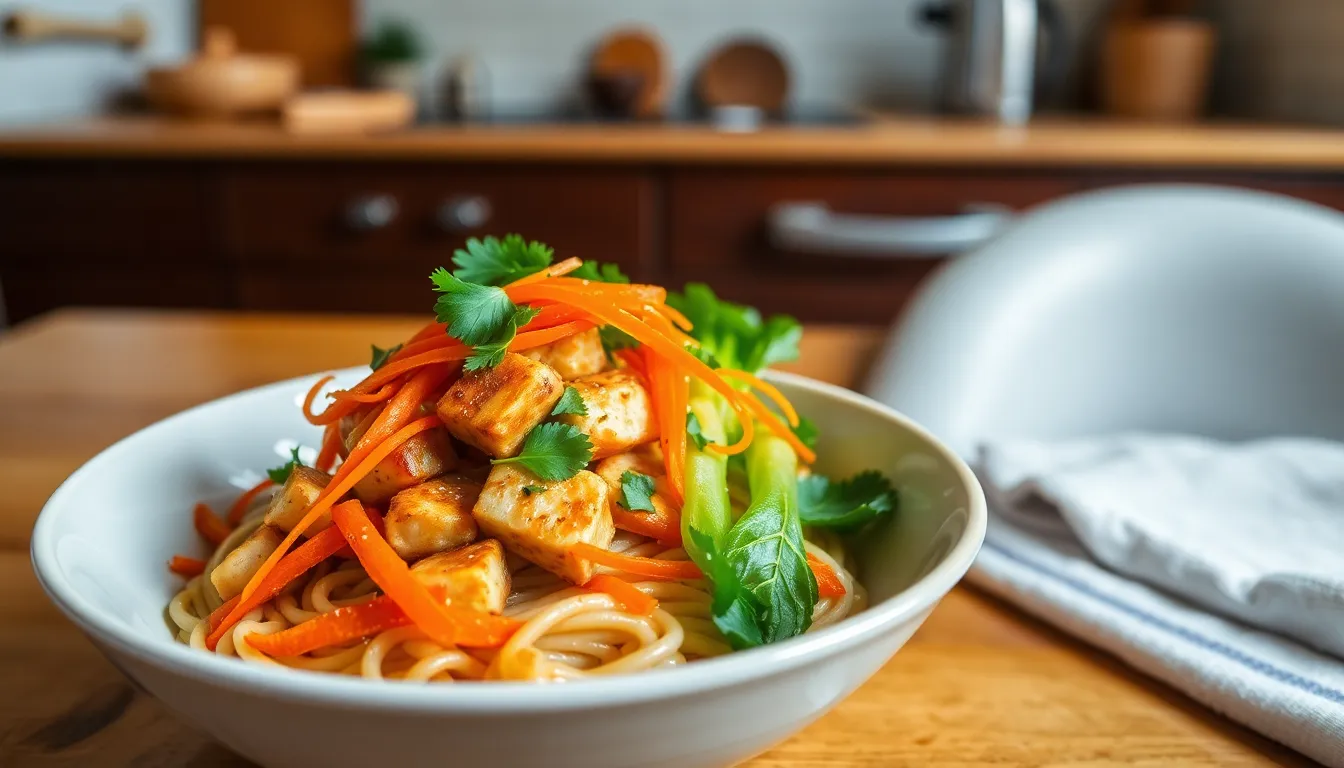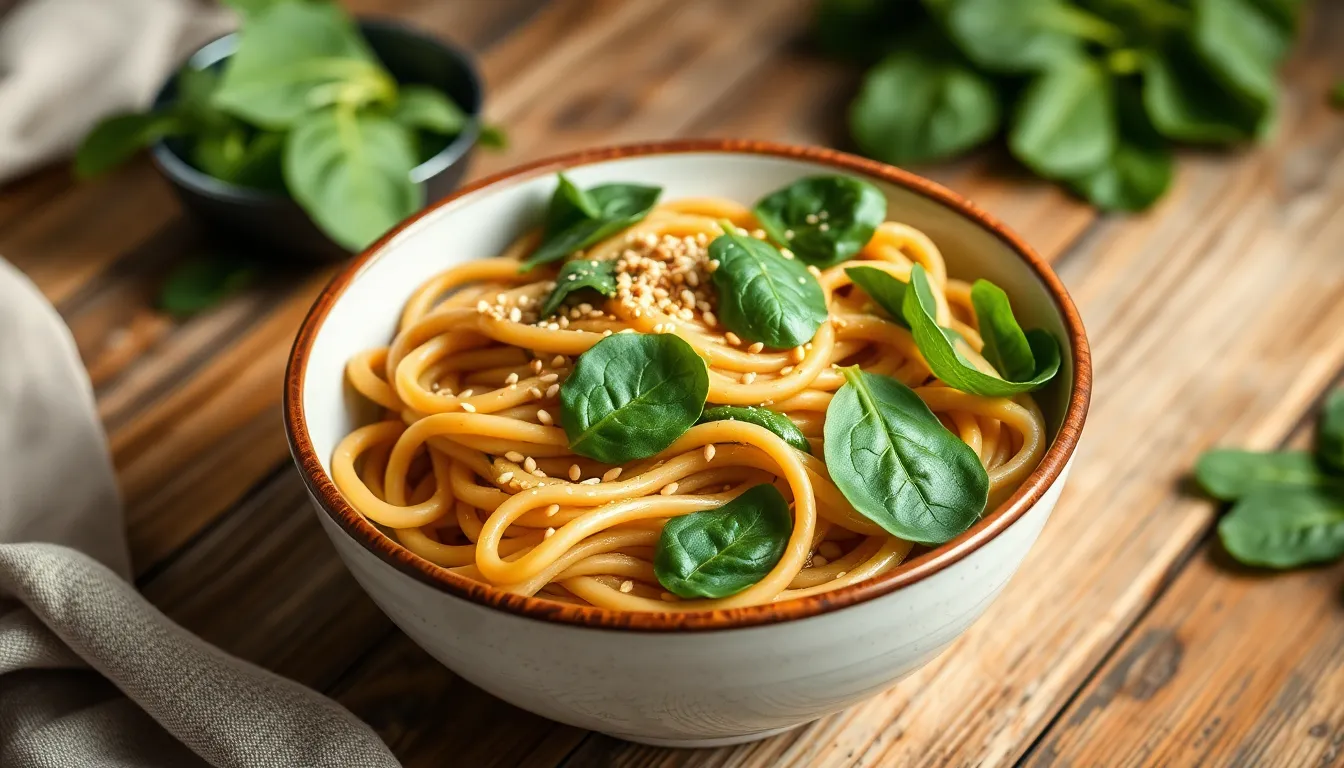Are you craving a dish that’s both comforting and sophisticated? Sesame brown butter udon noodles might just become your new weeknight obsession.
These thick, chewy udon noodles coated in nutty brown butter and aromatic sesame create a symphony of flavors that’s impossible to resist. The magic happens when butter transforms into a golden-brown elixir, releasing its toasty notes that perfectly complement the earthiness of sesame. It’s a simple yet elevated dish that comes together in minutes but tastes like it took hours.
You’ll love how versatile this recipe is—add your favorite vegetables or protein to make it a complete meal. Whether you’re cooking for one or entertaining guests, these sesame brown butter udon noodles deliver restaurant-quality taste with minimal effort.
Why You’ll Love These Sesame Brown Butter Udon Noodles
These sesame brown butter udon noodles will quickly become your new weeknight favorite for several compelling reasons:
- Ready in 15 minutes – Perfect for busy evenings when you need something delicious without spending hours in the kitchen
- Minimal ingredients – Requires just a handful of pantry staples you likely already have on hand
- Incredible depth of flavor – The combination of nutty brown butter and toasted sesame creates complexity that tastes like you spent hours cooking
- Versatile base – Works beautifully as is or can be customized with your favorite proteins and vegetables
- Satisfying texture – Thick chewy udon noodles provide the perfect vehicle for the rich sauce
The magic happens when butter transforms into its golden brown state, releasing a nutty aroma that pairs perfectly with the earthy notes of sesame. This simple technique elevates ordinary noodles into something truly special with minimal effort on your part.
Your dinner guests will think you’ve mastered some complex culinary technique when in reality you’ve just discovered the perfect balance of flavors through this straightforward preparation method. The silky sauce clings perfectly to each udon noodle creating a satisfying mouthfeel with every bite.
For meal preppers this dish reheats beautifully making it an excellent option for lunch the next day. The flavors actually continue to develop overnight creating an even more delicious second-day experience.
What Are Udon Noodles?

Udon noodles stand out as thick wheat noodles originating from Japan that offer an irresistibly chewy texture unlike any other pasta variety. These substantial noodles measure approximately 4-6mm in width and possess a distinctively soft yet substantial mouthfeel that makes them instantly recognizable in any dish.
Traditional Japanese cuisine features these versatile noodles in many preparations ranging from hot soups to stir-fried dishes. Their neutral wheat flavor creates the perfect canvas for bold sauces and seasonings while their substantial texture ensures they hold up beautifully to various cooking techniques.
Fresh udon noodles deliver the ultimate texture experience but frozen varieties offer nearly identical quality and convenience for home cooks. Most supermarkets stock these noodles in the refrigerated or frozen Asian food sections making them readily accessible for weeknight cooking adventures.
The thickness and chewiness of udon noodles make them particularly well-suited for our sesame brown butter sauce. Unlike thinner noodle varieties udon stands up to the rich brown butter without becoming soggy while their substantial texture provides satisfying bites that perfectly complement the nutty sesame flavors.
When cooking udon noodles you’ll notice they require less time than traditional Italian pasta typically becoming tender in just 2-3 minutes. Their ability to absorb flavors while maintaining their distinctive bite makes them the ideal foundation for this quick yet sophisticated dish.
Key Ingredients for Sesame Brown Butter Udon Noodles

Creating the perfect sesame brown butter udon noodles depends on selecting quality ingredients that complement each other. These key components work together to create a dish with remarkable depth of flavor even though its simplicity.
Choosing the Right Udon Noodles
Fresh udon noodles deliver the best chewy texture and subtle sweet undertone that distinguishes this dish. Their thick, substantial nature (typically 4-6mm wide) allows them to hold up beautifully against the rich brown butter sauce without becoming soggy. Frozen udon makes an excellent alternative when fresh isn’t available, offering nearly the same satisfying bite. Shelf-stable varieties work in a pinch but may lack some of the signature chewiness that makes udon so special. Remember that udon requires minimal cooking time—just 2-3 minutes until tender—making them perfect for quick weeknight meals.
The Perfect Brown Butter
Brown butter forms the luxurious foundation of this dish, transforming ordinary butter into a nutty, aromatic elixir. Start with unsalted butter (or vegan butter for a plant-based option) and heat it slowly over medium heat until it begins to foam. Continue cooking while stirring frequently until the milk solids turn golden brown and release a distinctly nutty aroma. This process requires your full attention to prevent burning—the difference between perfectly browned and burnt butter happens in seconds. Adding black pepper while browning infuses the butter with additional warmth and complexity, improving the overall flavor profile. The resulting brown butter provides a rich depth that elevates simple udon noodles to restaurant-quality status.
Sesame Components
Toasted sesame seeds contribute essential texture and nutty flavor, creating a perfect partnership with the brown butter. Sprinkle them generously over your finished dish for visual appeal and delightful crunch. Toasted sesame oil adds another dimension of sesame aroma—just a small amount dramatically enhances the dish’s complexity. These sesame elements work alongside soy sauce (preferably a mix of low-sodium and dark varieties) to create a balanced umami profile. A small pinch of sugar helps round out the flavors, while optional additions like garlic, ginger, or chili crisp can customize the heat level to your preference. Baby spinach introduces a nutritional boost and vibrant color contrast against the golden noodles, completing this sophisticated yet simple dish.
Equipment Needed

Preparing sesame brown butter udon noodles requires minimal kitchen equipment yet delivers maximum flavor impact. Here’s everything you need to bring this 15-minute wonder to your table:
- Large pot – For boiling your udon noodles to that perfect chewy texture
- Colander – To drain the noodles while preserving some cooking water
- Medium skillet or pan – Preferably with a light-colored bottom so you can monitor the butter as it browns
- Wooden spoon or heat-resistant spatula – For stirring and tossing the noodles in that luscious brown butter sauce
- Measuring spoons – For accurate seasoning with soy sauce and other flavor enhancers
- Cutting board and chef’s knife – To prepare any fresh ingredients like spinach or aromatics
- Tongs or cooking chopsticks – Makes tossing and serving the noodles much easier
- Serving bowls – Wide shallow bowls work best for presenting these saucy noodles
Your skillet should be large enough to accommodate all ingredients without overcrowding which ensures proper sauce distribution. The light-colored bottom helps you see the butter’s color transformation as it develops those essential nutty notes. Keep your tongs handy for the final tossing stage when you’ll incorporate the noodles with the sauce creating that silky coating that makes this dish so irresistible.
Ingredients

Gather these simple yet groundbreaking ingredients to create your sesame brown butter udon noodles. The recipe divides into three components that work together to create a perfectly balanced dish.
For the Noodles
- 8 to 16 ounces fresh or frozen udon noodles
- 5 ounces baby spinach (or up to 1 pound coarsely chopped mature spinach)
- Salt for cooking noodles
For the Sesame Brown Butter Sauce
- 2 to 6 tablespoons unsalted butter or vegan butter (Miyoko’s works well)
- 1 tablespoon low-sodium soy sauce
- 1/2 to 1 teaspoon coarsely ground black pepper
- 1-2 teaspoons granulated sugar or brown sugar (optional)
- 1 to 2 tablespoons toasted sesame seeds
- 2 tablespoons toasted sesame oil (optional for enhanced sesame flavor)
For Garnish
- Additional toasted sesame seeds
- Sliced green onions
- Chili crisp (optional for heat and texture)
Instructions

Follow these simple steps to create your sesame brown butter udon noodles with perfect texture and flavor. This dish comes together quickly once you master each component.
How to Brown Butter
Select a light-colored pan or skillet that allows you to monitor the butter’s color change easily. Cut unsalted butter into pieces and place them in the pan over medium heat. Stir continuously as the butter melts, watching as it foams and begins to brown while milk solids settle at the bottom. Look for small golden to bronze bits forming at the bottom of the pan and a nutty, caramelized aroma—this indicates perfectly browned butter. Remove from heat immediately when you reach this stage to prevent burning. Transfer the brown butter to a heat-resistant container, making sure to include all the toasted solids as they contribute important flavor.
Preparing the Sauce
Mix your freshly browned butter with toasted sesame seeds and sesame oil to create a rich flavor foundation. Add soy sauce, a pinch of sugar, and black pepper to the mixture, balancing the savory umami notes. Consider incorporating minced garlic or grated ginger for additional depth if desired. Warm the sauce gently over low heat just enough to meld the flavors without cooking off the nutty aroma of the brown butter. Taste and adjust seasonings as needed before adding your noodles.
Cooking the Udon Noodles
Bring a large pot of water to a rolling boil and add a generous pinch of salt. Add your fresh or frozen udon noodles to the boiling water, stirring occasionally to prevent sticking. Cook according to package instructions—typically 2-3 minutes for fresh noodles and 8-12 minutes for dried varieties. Test for doneness by sampling a noodle; it should be chewy yet tender with no hard center. Drain the noodles in a colander and rinse briefly under cold water to stop the cooking process and remove excess starch for better sauce adhesion.
Combining Everything Together
Return your drained udon noodles to the pot or a large bowl. Pour the warm sesame brown butter sauce over the noodles. Toss thoroughly using tongs or two spoons until every strand is evenly coated with the glossy sauce. Add baby spinach if using and continue tossing until the leaves wilt slightly from the residual heat. Divide the dressed noodles among serving bowls. Garnish with additional toasted sesame seeds, sliced green onions, and optional chili crisp for heat. Serve immediately while hot to enjoy the full spectrum of flavors and the perfect chewy texture of the noodles.
Serving Suggestions

Present your sesame brown butter udon noodles piping hot for the most satisfying experience. The rich brown butter sauce tends to thicken slightly as it cools creating the perfect coating for each strand of chewy udon. Serve immediately in shallow bowls or plates with high edges to contain the saucy noodles and make twirling easier.
Garnish generously with additional toasted sesame seeds to enhance the nutty flavor profile that defines this dish. Sprinkle freshly sliced green onions on top for a pop of color and mild onion flavor that cuts through the richness of the brown butter sauce. For those who enjoy heat a drizzle of chili crisp or scatter of red pepper flakes adds welcome complexity and visual appeal.
Balance the richness of these noodles with complementary side dishes. A simple cucumber salad dressed with rice vinegar provides refreshing acidity that contrasts beautifully with the buttery noodles. Pickled vegetables like quick-pickled radishes or kimchi offer tangy crunch that cleanses the palate between bites.
These noodles work perfectly as a standalone meal for busy weeknights when you need something substantial yet quick. For more elaborate occasions pair with a protein element such as grilled chicken miso salmon or crispy tofu to create a more complete dining experience. The neutral yet flavorful base of the noodles complements virtually any protein addition.
Consider serving family-style for casual gatherings allowing everyone to add their preferred garnishes. Set out small bowls of additional sesame seeds sliced scallions chili crisp and perhaps some furikake or nori strips for guests to customize their bowls. This interactive approach makes the meal more captivating while accommodating different spice preferences.
For a complete Japanese-inspired meal serve smaller portions of these noodles alongside miso soup and a simple green salad dressed with sesame vinaigrette. This combination creates a balanced meal with varied textures and flavors while maintaining the sesame theme throughout each component.
Make-Ahead and Storage Tips

These sesame brown butter udon noodles aren’t just delicious when freshly made—they’re also perfect for meal prep enthusiasts. You can prepare components in advance to streamline your cooking process on busy weeknights.
Prepare Components Ahead:
- Cook udon noodles until just al dente, rinse with cold water, and toss with a tiny bit of sesame oil to prevent sticking
- Brown the butter separately and store in an airtight container
- Wash and prepare spinach, storing it dry in the refrigerator
- Toast sesame seeds in advance and keep in a sealed container
Storage Answers:
Store leftover noodles in an airtight container in your refrigerator for up to 3 days. The flavors actually develop overnight, making day-two noodles sometimes even more delicious than freshly made ones.
Reheating Instructions:
Gently warm the noodles in a skillet over medium-low heat. Add a splash of water (about 1-2 tablespoons) to help loosen the sauce and prevent drying. Stir frequently until heated through, which typically takes 3-4 minutes. Alternatively, microwave in 30-second increments, stirring between each until warmed to your liking.
Freezing Note:
While possible to freeze these noodles, the texture may change slightly upon thawing. If you choose to freeze, store the noodles and sauce separately in freezer-safe containers for up to 1 month. Thaw overnight in the refrigerator before reheating.
Refreshing Leftovers:
Add a fresh drizzle of sesame oil and a sprinkle of newly toasted sesame seeds when serving leftovers to reinvigorate the flavors and presentation. A squeeze of fresh lemon juice can also brighten the dish if it seems a bit flat after storage.
Recipe Variations

Sesame brown butter udon noodles offer endless possibilities for customization while maintaining their signature nutty rich flavor profile. You can easily adapt this versatile dish to suit your preferences and what you have available in your kitchen.
Protein Additions
Transform your udon noodles into a more substantial meal by incorporating protein options that complement the rich sesame brown butter sauce. Tofu works beautifully in this dish—try pan-frying firm tofu until golden or adding silken tofu for a creamy texture contrast. Grilled chicken strips provide a savory element that pairs wonderfully with the nutty sauce. Shrimp or prawns cook quickly and absorb the flavors of the brown butter and sesame. Eggs make an excellent addition too—consider topping your noodles with a soft-boiled or poached egg that creates a luscious sauce when the yolk breaks. These protein additions not only enhance the dish’s nutritional profile but also make it more satisfying as a complete meal.
Vegetable Options
Incorporate colorful vegetables to add nutrition texture and visual appeal to your sesame brown butter udon noodles. Baby spinach remains the classic choice but many other vegetables work wonderfully in this dish. Bok choy or baby bok choy adds a pleasant crunch and mild flavor when lightly sautéed. Shredded carrots bring natural sweetness and vibrant color. Mushrooms such as shiitake or cremini contribute earthy umami notes that enhance the brown butter’s nuttiness. Bell peppers introduce a sweet crunch and bright color contrast. Snow peas or snap peas retain their delightful crispness even after cooking making them perfect textural additions. Prepare your chosen vegetables by steaming sautéing or microwaving them briefly before folding into the noodles to maintain their integrity while absorbing the delicious sauce.
Spice Level Adjustments
Customize the heat in your sesame brown butter udon noodles to match your spice preference. For a mild approach simply add freshly cracked black pepper or a light sprinkle of mild chili flakes to enhance the dish without overwhelming it. Medium spice lovers should consider incorporating chili crisp or a drizzle of chili oil either mixed into the sauce or used as a flavorful topping. Heat enthusiasts can dial up the intensity by adding fresh chopped chilies sambal oelek or a generous portion of chili crisp for a fiery experience. The beauty of adjusting spice levels yourself means you can create a family-friendly version in the main pot while offering spicy condiments on the side for those who prefer more heat. This flexibility allows everyone at your table to enjoy these noodles exactly as they like them.
Nutritional Information

Understanding the nutritional profile of these sesame brown butter udon noodles helps you make informed dietary choices while enjoying this delicious dish. Each serving delivers a satisfying balance of carbohydrates, fats, and proteins that combine to create a filling meal.
A typical serving of sesame brown butter udon noodles (approximately half of the recipe) contains around 450-600 calories. The bulk of these calories comes from the udon noodles themselves, which contribute about 188 calories per serving and consist primarily of carbohydrates.
The nutritional breakdown per serving includes:
| Nutrient | Amount | Primary Sources |
|---|---|---|
| Calories | 450-600 kcal | Udon noodles, butter, sesame seeds |
| Carbohydrates | 60-75g | Primarily from udon noodles |
| Fat | 20-30g | Butter and sesame seeds |
| Protein | 10-15g | Noodles, seeds, and spinach |
Udon noodles form the foundation of this dish, providing substantial carbohydrates that deliver energy. Their macronutrient profile typically consists of about 80% carbohydrates, 15% protein, and 5% fat.
The butter component adds richness and approximately 200 calories (for 2 tablespoons) to the overall dish. Sesame seeds contribute not only fantastic flavor but also healthy fats, fiber, and about 50-60 calories per tablespoon.
Adding baby spinach boosts the nutritional value significantly without substantially increasing the calorie count. Five ounces of spinach adds only about 35 calories while providing important vitamins, minerals, and fiber.
The soy sauce and seasonings contribute minimal calories but add tremendous flavor to the dish. Their sodium content should be noted if you’re monitoring salt intake, though using low-sodium soy sauce can help mitigate this concern.
This dish strikes an appealing balance between indulgence and nutrition. The rich brown butter creates a satisfying mouthfeel while the sesame seeds provide heart-healthy fats. When you incorporate vegetables like spinach, you further enhance the nutritional profile with essential vitamins and minerals.
For those tracking macronutrients, this dish fits well into a balanced diet that includes moderate carbohydrate intake. The protein content makes it satisfying, while the fat content contributes to the dish’s rich flavor profile and helps keep you full longer.
The Perfect Sesame Brown Butter Udon Noodles Every Time
These sesame brown butter udon noodles bring restaurant-quality dining to your kitchen in just 15 minutes. The magic happens when nutty brown butter meets chewy udon noodles and aromatic sesame creating a dish that’s greater than the sum of its parts.
You’ll find yourself returning to this recipe again and again for its versatility and depth of flavor. Whether enjoyed as a quick weeknight dinner or as part of an elaborate spread for guests these noodles deliver comfort with sophistication.
Give this recipe a try and discover how a few quality ingredients can transform into something extraordinary. With endless customization options and minimal cleanup you’ve got the perfect recipe to add to your regular rotation. Your future self will thank you!
Frequently Asked Questions
What are sesame brown butter udon noodles?
Sesame brown butter udon noodles are a comforting yet sophisticated dish that combines thick, chewy Japanese udon noodles with nutty brown butter and aromatic sesame flavors. This quick meal comes together in just 15 minutes but offers complex flavors that taste like they took much longer to develop. The dish balances rich butter with toasted sesame and umami from soy sauce for a restaurant-quality experience at home.
How long does it take to make these noodles?
These noodles take only 15 minutes to prepare from start to finish, making them perfect for busy weeknights. The udon noodles themselves cook in just 2-3 minutes, while the brown butter sauce takes about 5 minutes to prepare. The quick cooking time doesn’t compromise flavor, as the browning process creates a deep, nutty flavor profile that tastes like it developed over hours.
What are udon noodles exactly?
Udon noodles are thick wheat noodles from Japan known for their distinctively chewy texture. They typically measure 4-6mm in width and have a neutral flavor that makes them versatile for various dishes. While traditionally used in hot soups and stir-fries, their substantial texture allows them to hold up well with bold sauces without becoming soggy. Fresh udon provides the best experience, but frozen varieties work well too.
Can I make this dish ahead of time?
Yes, these noodles are excellent for meal prep. Cook the udon just until al dente and prepare the brown butter separately. Store components in airtight containers in the refrigerator for up to three days. The flavors actually develop overnight, making leftovers even more delicious. Reheat gently in a skillet or microwave with a splash of water. Add fresh garnishes just before serving to maintain their texture.
What equipment do I need to make this recipe?
You need minimal equipment: a large pot for boiling noodles, a colander for draining, a medium skillet (preferably with a light-colored bottom to monitor butter browning), and basic utensils like a wooden spoon or tongs. The light-colored skillet is particularly helpful for seeing the butter’s color change as it browns, preventing burning and ensuring the perfect nutty flavor.
How can I customize these noodles?
This versatile dish can be customized in numerous ways. Add proteins like tofu, grilled chicken, shrimp, or a fried egg for extra substance. Incorporate vegetables such as bok choy, carrots, mushrooms, or bell peppers for nutrition and color. Adjust the spice level with chili crisp, sriracha, or red pepper flakes. You can even swap the soy sauce for tamari to make it gluten-free (with gluten-free noodles).
Are these noodles healthy?
A typical serving contains 450-600 calories with 60-75g carbohydrates, 20-30g fat, and 10-15g protein. The dish offers a balance between indulgence and nutrition: carbohydrates from noodles provide energy, sesame seeds contribute healthy fats, and baby spinach adds vitamins and minerals. While the butter adds richness, you can adjust portions or substitute some ingredients to align with specific dietary goals while maintaining flavor.
What’s the best way to serve these noodles?
Serve these noodles piping hot in shallow bowls to contain the sauce. Garnish with additional toasted sesame seeds and sliced green onions. For a complete meal, pair with sides like cucumber salad or pickled vegetables to balance the richness. These noodles work well served family-style for casual gatherings, allowing guests to customize with various toppings like extra chili crisp, herbs, or lime wedges.
What’s the secret to perfect brown butter?
The secret to perfect brown butter is patience and attention. Use a light-colored pan to monitor color changes as the butter melts and the milk solids separate. Keep heat at medium-low and stir occasionally. Watch for the transition from yellow to golden to amber, and remove from heat when you detect a nutty aroma. The entire process takes 4-5 minutes. Stop cooking immediately when it reaches amber to prevent burning.
Can I use regular pasta instead of udon noodles?
While you can substitute thick pasta like fettuccine or linguine, the dish will lose the signature chewy texture that makes udon special. If substituting, cook the pasta al dente to maintain some chewiness. Asian wheat noodles like lo mein or Chinese egg noodles make better alternatives. Remember that different noodles have different cooking times, so adjust accordingly to avoid mushy results.
